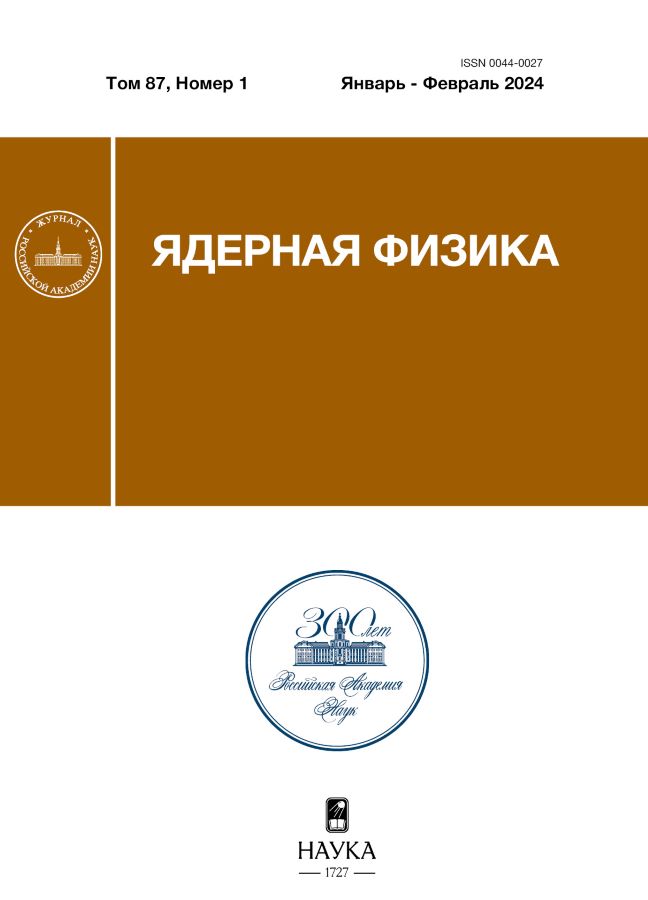Cosmophysical aspects of relativistic nuclear fragmentation
- Autores: Zaitsev A.A.1,2, Marimuthu N.1, Artemenkov D.A.1, Zarubin P.I.1,2, Peresadʹko N.G.1,2, Rusakova V.V.1
-
Afiliações:
- Joint Institute for Nuclear Research
- P. N. Lebedev Physical Institute of the Russian Academy of Sciences
- Edição: Volume 87, Nº 1 (2024)
- Páginas: 40-44
- Seção: ЭЛЕМЕНТАРНЫЕ ЧАСТИЦЫ И ПОЛЯ. Эксперимент
- ##submission.datePublished##: 03.10.2024
- URL: https://cardiosomatics.ru/0044-0027/article/view/674672
- DOI: https://doi.org/10.31857/S0044002724010066
- EDN: https://elibrary.ru/KEDJQJ
- ID: 674672
Citar
Texto integral
Resumo
The status of the study of multiple fragmentation of 950 MeV per nucleon Kr nuclei in a nuclear track emulsion aimed at determining the contributions of 2α decays of 8Be, the Hoyle 3α state, and the search for a 4α particle condensate state, is presented. In events with the production of few relativistic fragments of He and H, the possibility of estimating the multiplicity of neutrons in the fragmentation cone of a projectile nucleus is studied. For the planar component of neutron transverse momenta estimated from the angles of observed secondary stars, the Rayleigh distribution parameter was 35 ± 7 MeV/c. The importance of such events for the interpretation of cosmophysical observations is noted.
Texto integral
Sobre autores
A. Zaitsev
Joint Institute for Nuclear Research; P. N. Lebedev Physical Institute of the Russian Academy of Sciences
Autor responsável pela correspondência
Email: zaicev@jinr.ru
Rússia, Dubna; Moscow
N. Marimuthu
Joint Institute for Nuclear Research
Email: zaicev@jinr.ru
Rússia, Dubna
D. Artemenkov
Joint Institute for Nuclear Research
Email: zaicev@jinr.ru
Rússia, Dubna
P. Zarubin
Joint Institute for Nuclear Research; P. N. Lebedev Physical Institute of the Russian Academy of Sciences
Email: zaicev@jinr.ru
Rússia, Dubna; Moscow
N. Peresadʹko
Email: zaicev@jinr.ru
Rússia
V. Rusakova
Joint Institute for Nuclear Research
Email: zaicev@jinr.ru
Rússia, Dubna
Bibliografia
- D. A. Artemenkov, V. Bradnova, O. N. Kashanskaya, N. V. Kondratieva, N. K. Kornegrutsa, E. Mitsova, N. G. Peresadko, V. V. Rusakova, R. Stanoeva, A. A. Zaitsev, I. G. Zarubina, and P. I. Zarubin, Phys. At. Nucl. 85, 528 (2022); doi.org/10.1134/S1063778822060035; arXiv: 2206.09690.
- A. Tohsaki, H. Horiuchi, P. Schuck, and G. Ropke, Rev. Mod. Phys. 89, 011002 (2017); doi.org/10.1103/RevModPhys.89.011002
- W. von Oertzen, Lect. Notes Phys. 818, 1 (2010); doi.org/10.1007/978-3-642-13899-7_3
- J. Abdallah et al. (DELPHI Collab.), Astophys. J. 28, 273 (2007); doi.org/10.1016/j.astropartphys.2007.06.001; arXiv: 0706.2561 [astro-ph].
- A. G. Bogdanov, R. P. Kokoulin, G. Manocchi, A. A. Petrukhin, and O. Saavedra, Astophys. J. 98, 13 (2018); doi.org/10.1016/j.astropartphys.2018.01.003
- V. S. Vorobev and A. A. Petrukhin, Phys. At. Nucl. 84, 934 (2021); doi.org/10.1134/S1063778821130408
- G. Trinchero, M. B. Amelchakov, A. G. Bogdanov, A. Chiavassa, A. N. Dmitrieva, G. Mannocchi, S. S. Khokhlov, R. P. Kokoulin, K. G. Kompaniets, A. A. Petrukhin, V. V. Shutenko, I. A. Shulzhenko, I. I. Yashin, and E. A. Yurina, Astophys. J. 945, 123 (2023); doi.org/10.3847/1538-4357/acb1fc; arXiv: 2210.09690.
- S. Typel, G. Röpke, T. Klähn, D. Blaschke, and H. H. Wolter, Phys. Rev. C 81, 015803 (2010); doi.org/10.1103/PhysRevC.81.015803; arXiv.org/ abs/0908.2344 [nucl-th].
Arquivos suplementares


















